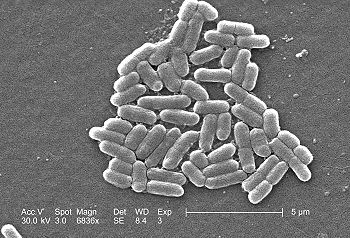Escherichia coli: Difference between revisions
imported>Richard Pettitt (added image) |
imported>Robert Badgett No edit summary |
||
| Line 4: | Line 4: | ||
'''''Escherichia coli''''' (commonly known as ''E. coli''), is one of the main species of [[bacteria]] living in the lower intestines of mammals, known as gut flora. When located in the large instestine, it assists with waste processing, vitamin K production, and food absorption. Discovered in 1885 by Theodor Escherich, a German pediatrician and bacteriologist, ''E. coli'' are abundant: the number of individual ''E. coli'' bacteria in the feces that a human defecates in one day averages between 100 billion and 10 trillion. However, the bacteria are not confined to this environment, and specimens have also been located, for example, on the edge of hot springs. | '''''Escherichia coli''''' (commonly known as ''E. coli''), is one of the main species of [[bacteria]] living in the lower intestines of mammals, known as gut flora. When located in the large instestine, it assists with waste processing, vitamin K production, and food absorption. Discovered in 1885 by Theodor Escherich, a German pediatrician and bacteriologist, ''E. coli'' are abundant: the number of individual ''E. coli'' bacteria in the feces that a human defecates in one day averages between 100 billion and 10 trillion. However, the bacteria are not confined to this environment, and specimens have also been located, for example, on the edge of hot springs. | ||
''Escherichia coli O157'' is a "verocytotoxin-producing serogroup belonging to the O subfamily of Escherichia coli which has been shown to cause severe food-borne disease. A strain from this serogroup, serotype H7, which produces shiga toxins, has been linked to human disease outbreaks resulting from contamination of foods by E. coli O157 from bovine origin."<ref>{{MeSH|Escherichia coli O157}}</ref> | |||
==References== | |||
<references/> | |||
Revision as of 15:04, 12 November 2008
Escherichia coli (commonly known as E. coli), is one of the main species of bacteria living in the lower intestines of mammals, known as gut flora. When located in the large instestine, it assists with waste processing, vitamin K production, and food absorption. Discovered in 1885 by Theodor Escherich, a German pediatrician and bacteriologist, E. coli are abundant: the number of individual E. coli bacteria in the feces that a human defecates in one day averages between 100 billion and 10 trillion. However, the bacteria are not confined to this environment, and specimens have also been located, for example, on the edge of hot springs.
Escherichia coli O157 is a "verocytotoxin-producing serogroup belonging to the O subfamily of Escherichia coli which has been shown to cause severe food-borne disease. A strain from this serogroup, serotype H7, which produces shiga toxins, has been linked to human disease outbreaks resulting from contamination of foods by E. coli O157 from bovine origin."[1]
References
- ↑ Anonymous (2025), Escherichia coli O157 (English). Medical Subject Headings. U.S. National Library of Medicine.
